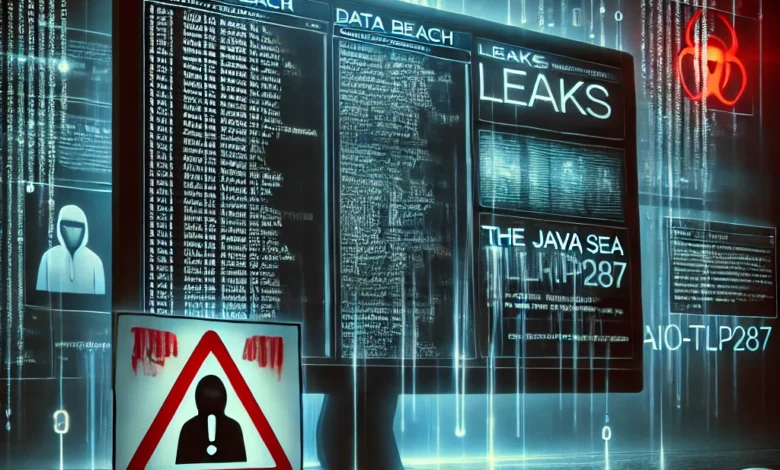TheJavaSea.me Leaks AIO-TLP287: A Major Data Breach Uncovered

In the digital age, data security remains a growing concern, with cyberattacks and data breaches becoming more frequent. One of the most recent and significant leaks, known as TheJavaSea.me Leaks AIO-TLP287, has caught the attention of cybersecurity experts and the public alike. This breach has exposed sensitive information, raising serious privacy and security issues for individuals and businesses.
This article explores the details of TheJavaSea.me Leaks AIO-TLP287, the extent of the exposure, its potential impact, and the necessary steps users should take to protect themselves.
What is TheJavaSea.me?
TheJavaSea.me is an online platform that has gained attention for hosting various types of data, including private and sensitive information. While some users visit the site for legitimate reasons, it has also been associated with leaked data, making it a point of concern in the cybersecurity world.
With the AIO-TLP287 leak, the platform has once again come under scrutiny, as a massive amount of confidential information has been exposed, potentially affecting millions of users worldwide.
Understanding TheJavaSea.me Leaks AIO-TLP287
The AIO-TLP287 designation refers to a particular batch of leaked data that has surfaced from TheJavaSea.me. The term “AIO” stands for “All-In-One,” indicating that this leak contains a wide range of information. The “TLP” (Traffic Light Protocol) classification suggests an internal labeling system used to manage the distribution of leaked data.
Scope of the Leak
The AIO-TLP287 leak is reportedly one of the most extensive breaches to date, affecting a significant number of users. Information included in the leak consists of:
- Personal details: Names, email addresses, phone numbers, and home addresses.
- Financial records: Credit card details, banking information, and transaction histories.
- Login credentials: Usernames and passwords for various online accounts.
- Private messages: Conversations from different platforms, potentially exposing sensitive discussions.
Such a massive exposure of private data poses a severe threat to affected individuals and businesses, increasing the risks of identity theft, financial fraud, and cyberattacks.
The Risks and Consequences of AIO-TLP287
Data breaches like TheJavaSea.me Leaks AIO-TLP287 have serious consequences. Here are some of the major risks associated with this particular leak:
1. Identity Theft and Fraud
With names, email addresses, and other personal details available, cybercriminals can use this information to impersonate individuals, apply for loans, or conduct fraudulent activities. Victims may find themselves dealing with unauthorized transactions or even legal troubles.
2. Financial Losses
Leaked credit card details and banking information put victims at risk of financial fraud. Hackers can use stolen payment information to make unauthorized purchases or drain funds from bank accounts.
3. Account Takeovers
The exposure of usernames and passwords means that hackers can gain unauthorized access to personal and business accounts. If users have reused passwords across multiple sites, the risk is even greater. This could lead to breaches in social media, emails, and even corporate networks.
4. Privacy Violations
For those whose private messages and confidential discussions were leaked, the damage could be personal or professional. Sensitive information falling into the wrong hands could lead to extortion, blackmail, or reputational harm.
5. Increased Phishing Attacks
Cybercriminals often use leaked data to craft targeted phishing attacks. Victims may receive fake emails or messages designed to trick them into providing additional sensitive information, further compromising their security.
How to Protect Yourself After TheJavaSea.me Leaks AIO-TLP287
If you suspect that your information may be included in the AIO-TLP287 leak, immediate action is necessary to mitigate potential risks. Here are some critical steps to take:
1. Change Your Passwords Immediately
- Update passwords for all online accounts, especially those associated with TheJavaSea.me.
- Use strong, unique passwords that combine letters, numbers, and symbols.
- Avoid reusing passwords across multiple platforms.
2. Enable Two-Factor Authentication (2FA)
- Activate 2FA for all critical accounts, including email, banking, and social media.
- This extra layer of security requires a second form of verification, making it harder for hackers to access your accounts.
3. Monitor Your Financial Activity
- Check bank and credit card statements regularly for unauthorized transactions.
- Report any suspicious activity to your financial institution immediately.
- Consider placing a fraud alert or credit freeze if your financial data was exposed.
4. Be Cautious of Phishing Attempts
- Do not click on links or download attachments from unknown emails.
- Verify messages requesting personal information by contacting the sender directly through official channels.
- Be skeptical of urgent or threatening messages designed to create panic.
5. Use a Password Manager
- A password manager can help generate and store strong passwords securely.
- This reduces the likelihood of using weak or reused passwords that hackers can easily crack.
6. Keep Your Software Updated
- Ensure that your devices and applications are running the latest security updates.
- Outdated software often contains vulnerabilities that cybercriminals exploit.
7. Check If Your Data Has Been Compromised
- Use online tools such as Have I Been Pwned to check if your email or passwords have been exposed in data breaches.
- If your information appears in a breach, take immediate steps to secure your accounts.
Read also: Ayo Edebiri Height: How Tall Is the Rising Star?
Conclusion
The TheJavaSea.me Leaks AIO-TLP287 is a significant cybersecurity incident with potentially severe consequences for affected users. The exposure of sensitive personal, financial, and login data highlights the ongoing need for strong security practices in the digital world.
By taking proactive measures, such as updating passwords, enabling two-factor authentication, and staying alert for phishing scams, individuals and businesses can reduce their risk and protect their information from further harm.
As cybersecurity threats continue to evolve, awareness and vigilance remain our best defense against future data breaches. Stay informed, stay secure, and take control of your online privacy before it’s too late.




